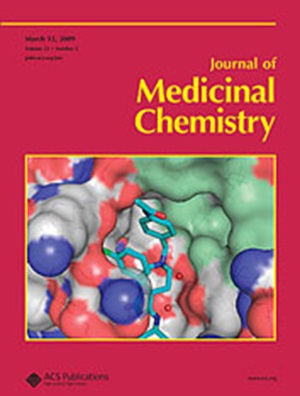SAR-Guided Development of Small-Molecule SERCA2a Activators: Discovery of Potent Indoline, Benzofuran, and Benzodioxole Analogs for Cardiovascular Applications.
IF 6.8
1区 医学
Q1 CHEMISTRY, MEDICINAL
引用次数: 0
Abstract
Heart failure (HF) remains a major public health burden, with current therapies focused primarily on symptom management. Impaired activity of the cardiac Ca2+ pump SERCA2a is a hallmark of HF and a promising therapeutic target, but limited structural data have hindered small-molecule development. Here, we report a comprehensive structure-activity relationship (SAR) investigation of small-molecule SERCA2a activators, beginning with natural product hits and progressing through iterative optimization of three pharmacophoric regions. This effort produced the largest collection of SERCA2a modulators to date─including 20 activators, 8 dual effectors, and 6 inhibitors. Several indoline, benzofuran, and benzodioxole analogs emerged as potent activators, increasing ATPase activity by ∼57% (EC50 = 0.7-9 μM). Notably, SERCA2a activation was inversely correlated with Ca2+ affinity, suggesting that SERCA2a stimulation occurs at the expense of Ca2+ binding. In summary, these findings identify key structural features that drive SERCA2a activity and establish a framework for developing next-generation SERCA2a-targeted therapies.sar引导下小分子SERCA2a激活剂的开发:发现用于心血管应用的强效吲哚、苯并呋喃和苯二唑类似物。
心力衰竭(HF)仍然是一个主要的公共卫生负担,目前的治疗主要集中在症状管理上。心脏Ca2+泵SERCA2a活性受损是HF的标志,也是一个有希望的治疗靶点,但有限的结构数据阻碍了小分子的发展。在这里,我们报告了小分子SERCA2a激活剂的全面结构-活性关系(SAR)研究,从天然产物命中开始,通过三个药效区域的迭代优化进行。这项工作产生了迄今为止最大的SERCA2a调节剂集合,包括20个激活剂,8个双效应剂和6个抑制剂。几种吲哚、苯并呋喃和苯二唑类似物作为有效的活化剂出现,使atp酶活性增加约57% (EC50 = 0.7-9 μM)。值得注意的是,SERCA2a激活与Ca2+亲和力呈负相关,这表明SERCA2a刺激是以Ca2+结合为代价的。总之,这些发现确定了驱动SERCA2a活性的关键结构特征,并为开发下一代SERCA2a靶向疗法建立了框架。
本文章由计算机程序翻译,如有差异,请以英文原文为准。
求助全文
约1分钟内获得全文
求助全文
来源期刊

Journal of Medicinal Chemistry
医学-医药化学
CiteScore
4.00
自引率
11.00%
发文量
804
审稿时长
1.9 months
期刊介绍:
The Journal of Medicinal Chemistry is a prestigious biweekly peer-reviewed publication that focuses on the multifaceted field of medicinal chemistry. Since its inception in 1959 as the Journal of Medicinal and Pharmaceutical Chemistry, it has evolved to become a cornerstone in the dissemination of research findings related to the design, synthesis, and development of therapeutic agents.
The Journal of Medicinal Chemistry is recognized for its significant impact in the scientific community, as evidenced by its 2022 impact factor of 7.3. This metric reflects the journal's influence and the importance of its content in shaping the future of drug discovery and development. The journal serves as a vital resource for chemists, pharmacologists, and other researchers interested in the molecular mechanisms of drug action and the optimization of therapeutic compounds.
 求助内容:
求助内容: 应助结果提醒方式:
应助结果提醒方式:


